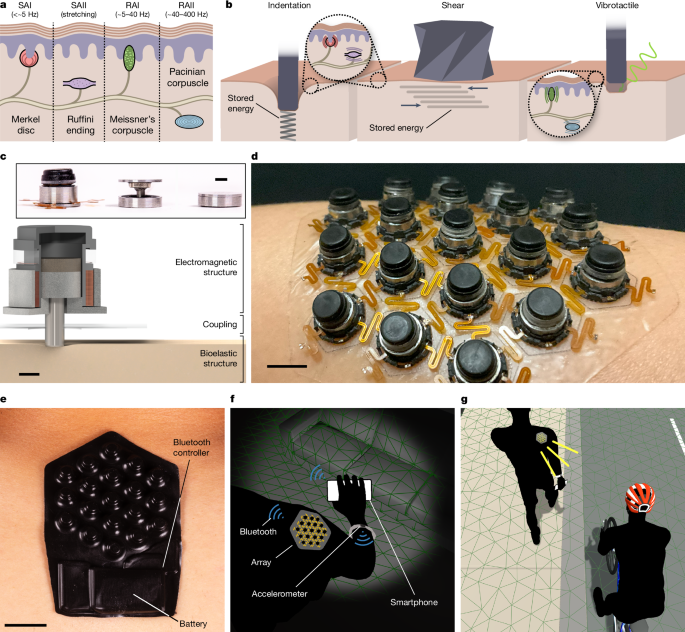Bolanowski, S. J. et al. Four channels mediate the mechanical aspects of touch. J. Acoust. Soc. Am. 84, 1680â1694 (1988).
Handler, A. & Ginty, D. D. The mechanosensory neurons of touch and their mechanisms of activation. Nat. Rev. Neurosci. 22, 521â537 (2021).
Lederman, S. J. & Klatzky, R. L. Hand movements: a window into haptic object recognition. Cogn. Psychol. 19, 342â368 (1987).
Lederman, S. J. & Klatzky, R. L. Haptic perception: a tutorial. Atten. Percept. Psychophys. 71, 1439â1459 (2009).
Shull, P. B. & Damian, D. D. Haptic wearables as sensory replacement, sensory augmentation and trainer â a review. J. Neuroeng. Rehabil. 12, 59 (2015).
Ko, S. H. & Rogers, J. Functional materials and devices for XR (VR/AR/MR) applications. Adv. Funct. Mater. 31, 2106546 (2021).
Zhang, Z. et al. Active mechanical haptics with high-fidelity perceptions for immersive virtual reality. Nat. Mach. Intell. 5, 643â655 (2023).
Lin, W. et al. Super-resolution wearable electrotactile rendering system. Sci. Adv. 8, eabp8738 (2022).
Yu, X. et al. Skin-integrated wireless haptic interfaces for virtual and augmented reality. Nature 575, 473â479 (2019).
Jung, Y. H. et al. A wireless haptic interface for programmable patterns of touch across large areas of the skin. Nat. Electron. 5, 374â385 (2022).
Leroy, E. & Shea, H. Hydraulically amplified electrostatic taxels (HAXELs) for full body haptics. Adv. Mater. Technol. 8, 2300242 (2023).
Turecek, J., Lehnert, B. P. & Ginty, D. D. The encoding of touch by somatotopically aligned dorsal column subdivisions. Nature 612, 310â315 (2022).
Neubarth, N. L. et al. Meissner corpuscles and their spatially intermingled afferents underlie gentle touch perception. Science 368, eabb2751 (2020).
Daly, C. H. Biomechanical properties of dermis. J. Invest. Dermatol. 79, 17sâ20s (1982).
Maeno, T., Kobayashi, K. & Yamazaki, N. Relationship between the structure of human finger tissue and the location of tactile receptors. JSME Int. J. Ser. C 41, 94â100 (1998).
Klatzky, R. L. & Peck, J. Please touch: object properties that invite touch. IEEE Trans. Haptics 5, 139â147 (2012).
Acome, E. et al. Hydraulically amplified self-healing electrostatic actuators with muscle-like performance. Science 359, 61â65 (2018).
Grasso, G., Rosset, S. & Shea, H. Fully 3D-printed, stretchable, and conformable haptic interfaces. Adv. Funct. Mater. 33, 2213821 (2023).
Qi, J. et al. HaptGloveâuntethered pneumatic glove for multimode haptic feedback in realityâvirtuality continuum. Adv. Sci. 10, 2301044 (2023).
Zhu, M. et al. in Proc. 2020 CHI Conference on Human Factors in Computing Systems 1â12 (Association for Computing Machinery, 2020).
Song, K. et al. Pneumatic actuator and flexible piezoelectric sensor for soft virtual reality glove system. Sci. Rep. 9, 8988 (2019).
Takahashi, N., Takahashi, H. & Koike, H. in Proc. 2019 IEEE World Haptics Conference (WHC) 217â222 (IEEE, 2019).
Haga, Y. et al. Dynamic Braille display using SMA coil actuator and magnetic latch. Sens. Actuators A Phys. 119, 316â322 (2005).
Karastoyanov, D. N., Atanassova, V. K. & Doukovska, L. A. in Proc. Third International Conference on Telecommunications and Remote Sensing 88â93 (SciTePress, 2014).
Vechev, V. et al. in Proc. 2019 IEEE Conference on Virtual Reality and 3D User Interfaces (VR) 312â320 (IEEE, 2019).
Song, E. et al. Miniaturized electromechanical devices for the characterization of the biomechanics of deep tissue. Nat. Biomed. Eng. 5, 759â771 (2021).
Li, D. et al. Miniaturization of mechanical actuators in skin-integrated electronics for haptic interfaces. Microsyst. Nanoeng. 7, 85 (2021).
Dhong, C. et al. Role of indentation depth and contact area on human perception of softness for haptic interfaces. Sci. Adv. 5, eaaw8845 (2019).
Grigorii, R. V., Colgate, J. E. & Klatzky, R. The spatial profile of skin indentation shapes tactile perception across stimulus frequencies. Sci. Rep. 12, 13185 (2022).
Lu, L., Leanza, S. & Zhao, R. R. Origami with rotational symmetry: a review on their mechanics and design. Appl. Mech. Rev. 75, 050801 (2023).
Zhang, C. et al. Plug & play origami modules with all-purpose deformation modes. Nat. Commun. 14, 4329 (2023).
Nolan, M. F. Quantitative measure of cutaneous sensation: two-point discrimination values for the face and trunk. Phys. Ther. 65, 181â185 (1985).
Mancini, F. et al. Whole-body mapping of spatial acuity for pain and touch. Ann. Neurol. 75, 917â924 (2014).
Wright, I. C. et al. The influence of foot positioning on ankle sprains. J. Biomech. 33, 513â519 (2000).
Lysdal, F. G. et al. What have we learnt from quantitative case reports of acute lateral ankle sprains injuries and episodes of âgiving-wayâ of the ankle joint, and what shall we further investigate? Sport. Biomech. 21, 359â379 (2022).
Leek, M. R. Adaptive procedures in psychophysical research. Percept. Psychophys. 63, 1279â1292 (2001).
Kim, J. T. et al. Mechanics of vibrotactile sensors for applications in skin-interfaced haptic systems. Extreme Mech. Lett. 58, 101940 (2023).
Jang, K. I. et al. Soft network composite materials with deterministic and bio-inspired designs. Nat. Commun. 6, 6566 (2015).
Girard, G., Martiny, M. & Mercier, S. Experimental characterization of rolled annealed copper film used in flexible printed circuit boards: identification of the elastic-plastic and low-cycle fatigue behaviors. Microelectron. Reliab. 115, 113976 (2020).


